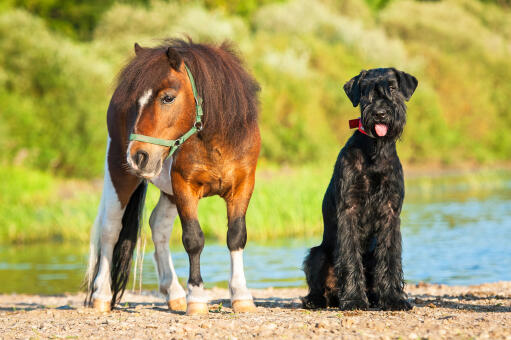Kæmpe Schnauzer hund






History
The Giant Schnauzer originates from Bavaria in Germany and dates back to the 1700's. It was the result of cross breeding the Standard Schnauzer, Black Great Dane and Bouvoir des Flandres. This produced a large dog that was suitable for guarding farms and shepherding cattle. Interest rose after the First World War and the breed moved to Towns and Cities, being used to guard shops and also by the Police and Military. By the 1960's the breed had made it's way to America where it soon became popular. The Giant Schnauzer is still used as a Police dog, by the Military and as search and rescue dogs.
Behaviour
The ultimate working dog, the Giant Schnauzer (Schnauze means Muzzle in German) is calm and loyal around it's family. It was bred to work and needs plenty of mental stimulation to keep it happy, but is content being around family and children. They need to learn early on that you (and the rest of your family) are boss as they have a tendency to try and achieve pack leader status if given the chance. They are protective of the home and naturally cautious with strangers. It is vital to invite lots of different people into the home when they are puppies, so they learn quickly that you allow people into the home. If raised with other dogs (and cats) they can usually live in harmony, however, they were bred to catch vermin, so aren't to be trusted with rodents. They are a quiet breed and only bark if they have a reason to.
Schnauzers are clever and have a quick mind. They learn easily and new consistent and firm handling; they are a large breed and need to be taught lead work to stop them pulling you over if they spot something. They don't take long to pick up new tasks and will remember them, but that doesn't mean that they will blindly obey all commands. They have a stubborn independent streak and will sometimes try and push limits. Puppy classes, and later, adult classes are recommend to reinforce all training. If you let training lapse, they will soon start to take advantage, so they need short training sessions daily to keep them in check.
Schnauzers like to roam and hunt out small furry things, so are best walked in a secure area. Their recall can be very good or very bad, so a long line is recommended for walks if not in a fenced area. They can walk and run for miles and never seem to tire, but a couple of long daily walks should be enough to keep them physically happy and content. They are happy playing in the garden and love a game of frisbee, so this can substitute one walk a day. However, if they don't receive enough exercise, they will become destructive as they get bored easily. They also make good jogging partners. They can excel at agility and obedience training.
Their coat requires regular grooming to keep it in good condition. Their beards/muzzles tend to get drool on them and need the occasional wipe. They need clipping every few months for pets and stripping every 4 weeks for show dogs.
With regard to health, they can suffer from Canine Hip Dysplasia, cataracts and have a much higher risk of cancers than many other breeds. Eye problems are also quite common.
Temperament
Giant Schnauzers have a playful and bold temperament. Giant Schnauzers are strong and energetic which can make them too boistrous for families with small children. They are watchful and protective of family which makes them good guard dogs but does mean they tend to be unfriendly to strangers. It is important that you show strong leadership in your training so that you gain the respect of these powerful dogs.
Health Problems
Health problems that may affect Giant Schnauzers include canine hip dysplasia (CHD), bloat, hypothyroidism, eye disease, blood clotting disease, allergies and autoimmune disease.
Breed Details
- Status: Common
- Life Expectancy: 12 - 14 years
- Weight: 34 - 43kg
- Højde: 23 - 27.5"
- Rare: Nej
- Coat: Medium - Lavt
- Grooming Requirements: Everyday
- Town or Country: Either
- Minimum Home Size: Large House
- Minimum Garden Size: Large Garden
- Størrelse: Medium
- Energy Level: Medium
- Exercise Required: Up to 2 hours










